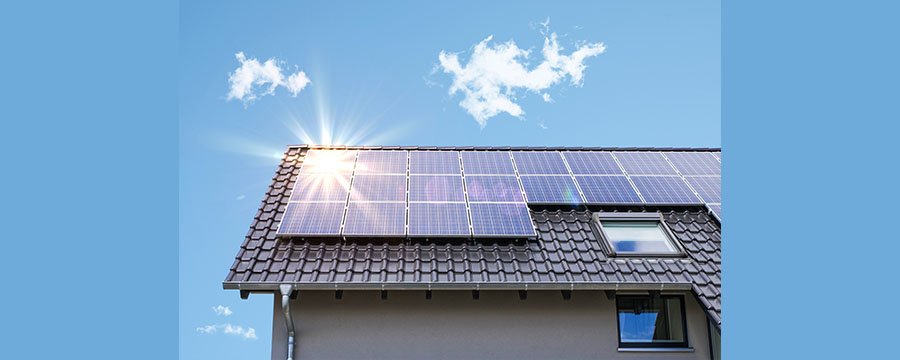Wanting to install solar and have no idea what to buy? Here is our cheat sheet to buying solar for your home!
Solar PV systems are becoming increasingly popular for homeowners who want to avoid the stress of rising power costs and consume electricity in a more sustainable way. With all the solar products and promises in the market, we want to help understand the factors you need to think about first before installing a solar photovoltaic (PV) system on your roof.
A good residential solar PV system depends on the efficiency and functionality of all the products that comprise a system. Depending on the functional and operational requirements of the system, the components required may include major units such as solar panels, DC-AC power inverter, battery storage system and battery controller.

(Source: thegrid.rexel.com)
Each component is essential in creating the perfect system in each type of home. To further learn about the major components, here’s a quick guide to create a reliable solar PV system for your home:
Solar Panels



This is where it all starts. Panels are the core of the solar system which is composed of solar cells that produce DC voltage whenever they receive energy from the sun. With hundreds of solar panels brands in the market, one can find it challenging to select which of this can give the optimal results.
The following factors should be your top considerations in having your solar panels.
Solar panel efficiency
Efficiency is the rate at which the panels can convert the solar energy into power. The panels with higher efficiency will be better because it will require lesser number of modules to generate the same amount of power as is generated from higher number of low efficiency panels. This will also save the area of panel installation. Therefore, good quality panels have efficiency ~20%, but generally you get 14-18% efficient panels. A higher efficiency rating is better, because it means that your solar panel can convert more of the sunlight it captures into electricity.
Power Output
Power output is an important metric for your home solar panel system. Output is the DC current that the panels produce. The panels with higher power rating are better. Generally, the power rating is 200-350W on the panels.
Manufacturer’s Credibility/ Product Warranty
Another vital factor to remember in choosing a solar panel is manufacturer’s credibility or the product warranty. It is critical to see whether the brand you are purchasing is bankable or not, based on its history or annual performance. That’s why Tier 1 brands such as Jinko Solar, JA Solar and Astronergy are generally a safe option as they are large well-known companies, enjoying national and international recognition and acceptance. These brands also comply with strict building standards in Australia.
Solar Inverters




Inverters are an essential part of any solar system; they are the brains of the network. Aside from the inverter’s primary role to convert DC power created by the sun into usable AC power (what we plug into our walls), its job is ever expanding. Inverters empower installers and proprietors to monitor how a system is performing. With the different types of inverters such as string solar inverters, hybrid inverters, off-grid inverters and micro inverters, homeowners should know which will work best for them.
According to Clean Energy, here are some of the criteria to be considered:
Quality & Reliability
The first thing to look for in a solar inverter is to see if it follows with the relevant Australian Standard (AS4777). You can have a quick check by visiting Clean Energy Council’s approved products list on their website.
Service, Support and Warranty
Typically, inverters like grid connected inverters have a life span extending from 10 to 20 years. You ought to anticipate that most will last 10 years minimum. Clearly, the longer the warranty, the more insurance you have for your inverter. But don’t forget to balance it against the inverter’s features.
Features
Weather-proof, expandable and high-efficiency are just some of the best features of an inverter. These inverters are made to be weather-proof, so they can be in areas that may have some exposure to different elements. Non-weather-proof inverters may require some cages that will have an extra cost.
If you are intending to expand your solar power system in the future, you should consider buying multiple MPPT (Maximum Power Point Tracking) inverter. These solar inverters have multiple MPPT trackers allowing you to add additional solar PV arrays later or install solar PV arrays at different orientations. Some solar panels have a small MPPT inverter attached to the rear of the module, usually called micro inverters.
An Inverter’s efficiency is as important of the features mentioned above. In inverter, efficiency is a measure of how well an inverter converts electricity it receives from energy sources into power that will be available in a home. Efficiency would only be a factor if two similar solar inverters had significantly different efficiency.
Monitoring
As mentioned earlier, inverters were not only made to simply convert DC power into useful energy in homes but can also be used to monitor the performance of a solar PV system. Some of the important information can be displayed are:
- Amount of energy (kilowatt hours) you have produced daily,
- the consumption of electricity (kilowatt hours) you have produced since the unit was installed
- the amount of power (kilowatts) the unit is currently producing
- the number of hours the unit has been producing power
Price
Inverters usually cost 20% of the whole solar system. Always remember not to buy the cheapest ones because there’s no chance of them lasting for 15 years plus. It better to buy reputable brands given that they are the most complex item on any solar PV system.
Some of the best residential solar inverters in 2018 according to Clean Energy are:
- Fronius – Primo and Galvo
- SolarEdge – SE and HD wave
- SMA – Sunny boy
- Sungrow – SG-KLT
Solar Battery
In order to maximize a solar PV system, solar batteries or battery banks are used to store excess energy from solar PV systems. Though, it is deemed optional, battery storage can be a big help when produced energy isn’t needed.
Maximizing savings – If the production surplus is sold to the electric utility, the rate paid is normally below the kWh price charged for consumption. Some PV system owners may prefer to store the surplus to use it when needed and save the full price of each kilowatt-hour instead of selling back to the grid at a reduced rate.
Backup power – A battery bank can store energy for electric service interruptions. Good battery storage products are offered by Sungrow, LG Chem and many other brands.
Installation
Aside from assuring that you have the best products on hand and will be able to select the most efficient ones, choosing a reliable and certified installer is of equal importance. To ensure that you are choosing an accredited installer refer to consult Clean Energy Council (CEC) list. CEC is Australia’s peak body representing the clean energy sector, who accredits both installers and systems that meet certain standards. To be qualified for any small-scale technology certificates, systems must be installed by a CEC-accredited installer.
Conclusion
In summary, installing a solar system is a significant investment for any home owner but worthy project if you wish to create renewable energy that is not only good for the environment but your pocket as well. There are many components that make up a residential solar PV system. To find one that is suitable for your home is not always straight and is why it is critical to do the necessary research and seek advice from accredited installers.
Want to see more article likes this? Subscribe to our mailing list using the form below.
Article Sources:
Barnes, C. (n.d.). Solar panels buying guide. Retrieved from https://www.choice.com.au/home-improvement/energy-saving/solar/buying-guides/solar-panels
Florida Solar Energy Center (n.d.). How A PV System Works. Retrieved from http://www.fsec.ucf.edu/en/consumer/solar_electricity/basics/how_pv_system_works.htm
The Grid (n.d.). Solar PV Systems: Overview of the Main Components. Retrieved from https://thegrid.rexel.com/en-us/knowledge/energy-efficiency/w/wiki/82/solar-pv-systems-overview-of-the-main-components
Shah, S. (2015, July 15). 5 Important Factors to consider before buying a Solar Panel. Retrieved from http://www.greenworldinvestor.com/2015/07/15/5-important-factors-to-consider-before-buying-a-solar-panel/
Rouse, M. (n.d.). tier 1 vendor. Retrieved from https://searchitchannel.techtarget.com/definition/tier-1-vendor
BDPQ (n.d.). Tier 1 Solar Panels List 2018. Retrieved from https://www.bspq.com.au/tier-1-solar-panels-list/
Solar Quotes (n.d.) Which are the best solar inverters?. Retrieved from /aa2c942bd995de31f00bb122d8d91466/inverters/
Svarc, J. (2018, May 12). Besy Solar Inverters 2018. Retrieved from https://www.cleanenergyreviews.info/blog/best-grid-connect-solar-inverters-sma-fronius-solaredge-abb





No Comments
Sorry, the comment form is closed at this time.